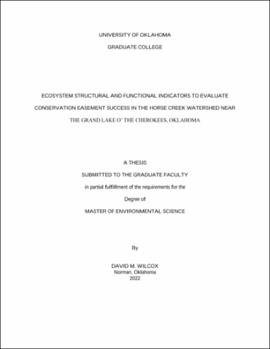| dc.description.abstract | Stream restoration activities in the United States commonly seek to improve aquatic and riparian structure. Traditional assessment methods evaluate ecosystem structure by estimating metrics such as biotic community assemblages, stream flow regimes, and riparian vegetation. However, very few assessments incorporate measures of ecosystem function, such as decomposition and productivity. In the Horse Creek watershed near the Grand Lake o’ the Cherokees in northeastern Oklahoma, stream restoration efforts take the form of cattle exclusion fences to address impaired stream habitat and water quality, and to decrease stress from livestock grazing on riparian vegetation. This study seeks to assess the impact of these conservation easements on ecosystem structure and function. Three sites were selected in the Horse Creek watershed, one within the conservation easement area and two outside of the exclusion fences. A reference stream, Fivemile Creek, was identified in the region for comparison. A geographic information system (GIS) evaluation of land use and land cover in the watersheds highlights a great degree of agricultural land use in the Horse Creek watershed, and a lesser anthropogenic impact in the Fivemile Creek watershed. Habitat assessments indicated that overall structural habitat quality was greatest at the reference site, lower in the conservation easement treatment site, and were the lowest at the two control sites. Fish and macroinvertebrate results indicate the greatest scores for biotic indices at the reference stream, followed by the conservation reach at Horse Creek, then the control reach. A remote sensing study of the watershed indicated that Normalized Difference Vegetation Index (NDVI) values increased during a two-year time interval in two of the three fenced-in conservation easement reaches, and aboveground biomass increased in all three fenced-in reaches. Ecosystem function was evaluated by estimating productivity and respiration through diel dissolved oxygen changes, and a cotton strip assay was conducted to evaluate rates of decomposition. Net primary productivity did not correlate to water quality, habitat metrics, or land use. Decomposition rates were lowest in the reference stream, were greater in the conservation easement site, and were greatest outside of the conservation easements. Results of metabolism and decomposition studies were treated as dependent variables and compared to physicochemical water quality parameters, watershed land use, and habitat metrics. These results support the use of cattle exclusion conservation easements to improve impaired water and habitat quality in the Horse Creek watershed. | en_US |
